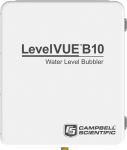
Easy to use software, reliable hardware






Visão Geral
The CRS451 consists of a water-level and water-temperature sensor that has its own time clock and memory to store the collected data, in a compact stainless-steel case. This frees users to place the sensor in remote sites and let it collect data for long periods. The sensor can then be retrieved, connected to a PC via a micro-USB port, and the data transferred to the PC. HydroSci software is included and elegantly supports test setup, data retrieval, and data display. Long battery life and rugged construction mean you can trust the CRS451 to collect important data. Low cost and ease of use make it a good choice in a variety of applications. The CRS456 is the same as this, but with a titanium case.
Leia maisBenefícios e Características
- Sensors and data-collection features in one instrument case
- Rugged stainless-steel case protects piezoresistive sensor
- Quality construction ensures product reliability
- Fully temperature-compensated
- Fast scan rate
- Large data-storage capacity
- Long battery life
- Easy-to-use software
imagens






Produtos Relacionados
Descrição Técnica
The CRS451 has several pressure range options. The CRS451 is unvented; therefore it is monitoring sealed gage pressure. For maximum accuracy, the data should be corrected for barometric pressure.
HydroSci software is available for download. This software simplifies the process of configuring the CRS451. Users can configure the CRS451 to monitor surface water, ground water, or a standard pump test.
HydroSci software will also compensate the measurements for barometric pressure using an additional CS451 or a CS456 as a reference sensor, or using a barometric pressure sensor from a nearby weather station.
HydroSci software will display the data in tabular or graphical formats.
Compatibilidade
Communications
Requires a micro USB cable and HydroSci software running on a computer with Windows XP or later. HydroSci software is available for download.
Especificações
| Venting | Unvented |
| Measurement Time | < 1.0 s |
| Output Options | micro USB |
| Internal Data Collection Memory | 4 MB |
| Logging/Scanning Modes | Standard, Delta, Wave, Logarithmic |
| Resolution | 0.0035% FS |
| Dry Storage Temperature Range |
-10° to +80°C WARNING: Sensor could be damaged if encased in frozen ice. |
| Operating Temperature Range |
0° to 60°C WARNING: Sensor could be damaged if encased in frozen ice. |
| Overpressure | 2 x pressure range |
| Power Requirements | Internal user-replaceable lithium battery |
| Water-Level Accuracy |
±0.1% full-scale-range TEB Includes the combined errors due to nonlinearity, hysteresis, nonrepeatability, and thermal effects over the compensated temperature range, per ISA S51.1. |
| Battery Life | 5 years (when logging interval is once per hour) |
| Body Material | 316L stainless steel |
| Temperature Accuracy | ±0.2°C |
| Ingress Protection | Exceeds IP68 |
| Diameter | 2.22 cm (0.875 in.) |
| Length | 22.23 cm (8.75 in.) |
| Weight | 230 g (0.51 lb) |
Power Consumption |
|
| Quiescent | < 80 µA |
| Measurement/Communication | 4 mA (1 s measurement) |
Measurement Ranges at Fresh Water Depths |
|
| 0 to 5.1 m (16.7 ft) |
|
| 0 to 10.2 m (33.4 ft) |
|
| 0 to 20.4 m (67 ft) |
|
| 0 to 50.9 m (167 ft) |
|
| 0 to 102 m (334.5 ft) |
|
Documentos Relacionados
Downloads
HydroSci v.1.2.1 (41.7 MB) 09-10-2017
HydroSci is used to configure and extract data from the CRS45X Recording Submersible Pressure Transducer and the OBS-3A Turbidity and Temperature Monitoring System.
Watch the Video Tutorial: Using HydroSci software with water-level recording sensors.
Perguntas Frequentes Relacionadas
Number of FAQs related to CRS451: 1
-
The CRS451 and CRS456 are unvented and monitor sealed gage pressure. For maximum accuracy, the data should be corrected for barometric pressure. The barometric pressure data from a nearby weather station or other monitoring platform can be used.







